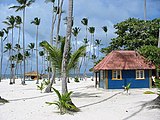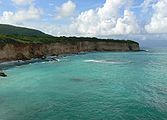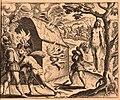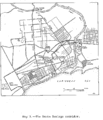Portal:Dominican Republic - Wikipedia
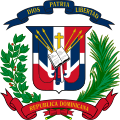
|
Welcome to Dominican Republic Portal |
Introduction
Dominican Republic República Dominicana (Spanish) | |
|---|---|
| Motto: "Dios, Patria, Libertad" (Spanish) "God, Homeland, Freedom" | |
| Anthem: ¡Quisqueyanos Valientes! Valiant Quisqueyans! | |
| ISO 3166 code | DO |
The Dominican Republic is a North American country located on the island of Hispaniola in the Greater Antilles archipelago of the Caribbean Sea, bordered by the Atlantic Ocean to the north. It occupies the eastern five-eighths of the island, which it shares with Haiti, making Hispaniola one of only two Caribbean islands, along with Saint Martin, that is shared by two sovereign states. It is the second-largest nation in the Antilles by area (after Cuba) at 48,671 square kilometers (18,792 sq mi), and second-largest by population, with approximately 11.4 million people in 2024, of whom approximately 3.6 million live in the metropolitan area of Santo Domingo, the capital city.
The Dominican Republic has the largest economy in the Caribbean and the seventh-largest in Latin America. Over the last 25 years, the Dominican Republic has had the fastest-growing economy in the Western Hemisphere – with an average real GDP growth rate of 5.3% between 1992 and 2018. GDP growth in 2014 and 2015 reached 7.3 and 7.0%, respectively, the highest in the Western Hemisphere. Recent growth has been driven by construction, manufacturing, tourism, and mining. The country is the site of the third largest (in terms of production) gold mine in the world, the Pueblo Viejo mine.
The Dominican Republic is the most visited destination in the Caribbean. The year-round golf courses and resorts are major attractions. A geographically diverse nation, the Dominican Republic is home to both the Caribbean's tallest mountain peak, Pico Duarte, and the Caribbean's largest lake and lowest point, Lake Enriquillo. The island has an average temperature of 26 °C (78.8 °F) and great climatic and biological diversity. The country is also the site of the first cathedral, castle, monastery, and fortress built in the Americas, located in Santo Domingo's Colonial Zone, a World Heritage Site. (Full article...)
Selected article - show another

The recorded history of the Dominican Republic began in 1492 when Christopher Columbus, working for the Crown of Castile, arrived at a large island in the western Atlantic Ocean, later known as the Caribbean. The native Taíno people, an Arawakan people, had inhabited the island during the pre-Columbian era, dividing it into five chiefdoms. They referred to the eastern part of the island as Quisqueya, meaning 'mother of all lands.' Columbus claimed the island for Castile, naming it La Isla Española ('the Spanish Island'), which was later Latinized to Hispaniola.
Following 25 years of Spanish occupation, the Taíno population in the Spanish-controlled regions of the island drastically decreased due to the Taíno genocide. With fewer than 50,000 survivors, those remaining intermixed with Spaniards, Africans, and others, leading to the formation of the present-day tripartite Dominican population. The area that would become the Dominican Republic remained the Captaincy General of Santo Domingo until 1821, except during the Era de Francia, when it was a French colony from 1795 to 1815. It briefly became an independent state in 1821, known as the Republic of Spanish Haiti, until it was annexed and merged by Haiti into Republic of Haiti from 1822 to 1844. (Full article...)
General images - load new batch
The following are images from various Dominican Republic-related articles on Wikipedia.
-
Battle of Vega Real (1494) (from History of the Dominican Republic)
-
National pantheon in Santo Domingo built from 1714 to 1746 (from History of the Dominican Republic)
-
Balaguer in 1966 (from History of the Dominican Republic)
-
A rally in China, 1966, in solidarity with the Dominican Republic Constitutionalists against the US. Slogans are visible e.g. "U.S. imperialism out of the Dominican Republic! Out of Latin America! Out of Vietnam! Out of our territory, Taiwan! (from History of the Dominican Republic)
-
Dominican Republic carnival parade costumes in San Juan de la Maguana (from Culture of the Dominican Republic)
-
Dominican Republic music culture. (from Culture of the Dominican Republic)
-
Ruins of Hospital San Nicolás de Bari (from History of the Dominican Republic)
-
Ruins of Monasterio de San Francisco (from History of the Dominican Republic)
-
Map of the Dominican Republic (Santo Domingo) and Haiti in 1921 (from History of the Dominican Republic)
-
Traditional cojuelo mask of the Dominican carnaval (from Culture of the Dominican Republic)
-
Rafael Trujillo (from History of the Dominican Republic)
-
Christopher Columbus statue in colonial Santo Domingo. (from Culture of the Dominican Republic)
-
Dominican native, fashion designer and perfume maker Oscar de la Renta (from Culture of the Dominican Republic)
-
The Guardia republicana, set up by President Cáceres in 1907 (from History of the Dominican Republic)
-
The Cathedral of Santa María la Menor, Santo Domingo, the first cathedral in the Americas, built 1512–1540. (from Culture of the Dominican Republic)
-
Massacre of Queen Anacaona and her subjects (from History of the Dominican Republic)
-
American Red Cross convoy in Santo Domingo, Dominican Republic, in 1916. (from History of the Dominican Republic)
-
Despite the slowing in economic growth, the economy of the Dominican Republic has far surpassed that of its neighbour Haiti from the 1970s onwards (from History of the Dominican Republic)
-
In 1511, Antonio de Montesinos denounced the abuses against the indigenous people (from History of the Dominican Republic)
-
Dominican Republic people in traditional culture dress. (from Culture of the Dominican Republic)
-
Painting by Johannes Vingboons of Santo Domingo, c. 1665 (from History of the Dominican Republic)
-
A bohío near Santo Domingo. Many Dominicans —especially those in rural areas— used to live in bohíos until well into the mid-20th century, like the native Taínos. (from Culture of the Dominican Republic)
-
Dominican singer/songwriter Juan Luis Guerra in concert, 2005 (from Culture of the Dominican Republic)
-
Arrival of Christopher Columbus, art by Dominican painter Luis Desangles. (from History of the Dominican Republic)
-
A group of peasant guerillas, known as gavilleros, who fought against the U.S. Marine occupation of the Dominican Republic (from History of the Dominican Republic)
-
Rafael Estrella (from History of the Dominican Republic)
-
Reception of American commissioners by President Báez, 1871. (from History of the Dominican Republic)
-
Safety corridor (from History of the Dominican Republic)
-
Camp of US Marines in the Dominican Republic during the occupation.
Fortaleza San Luis (Santiago de los Caballeros) (from History of the Dominican Republic) -
Dominican native and Major League Baseball player Albert Pujols. (from Culture of the Dominican Republic)
-
National pantheon in Santo Domingo. (from Culture of the Dominican Republic)
-
Mastrolilli residence interior by Dominican architect Rafael Calventi. (from Culture of the Dominican Republic)
-
Marine machine gun unit in Santo Domingo, Dominican Republic (from History of the Dominican Republic)
-
Dominican Republic dance culture. (from Culture of the Dominican Republic)
-
Balaguer in 1988 (from History of the Dominican Republic)
-
President Alejandro Woss y Gil taking office in 1903. (from History of the Dominican Republic)
-
Dominican Republic people and culture. (from Culture of the Dominican Republic)
-
Chicharrón mixto, is a common dish in the country derived from Andalusia in southern Spain. (from Culture of the Dominican Republic)
-
Chiefdoms of Hispaniola. Marién, Maguá, Maguana, Jaragua and Higüey (from History of the Dominican Republic)
-
Santo Domingo before the Haitian annexation (from History of the Dominican Republic)
-
Dominican Republic students with historical national flag. (from Culture of the Dominican Republic)
-
Lluvia en el mercado (English: Rain in the Market), 1942 (Museo de Arte Moderno, Santo Domingo). (from Culture of the Dominican Republic)
-
Rafael Trujillo in 1952 (from History of the Dominican Republic)
-
A Marine heavy machine gunner in Santo Domingo (from History of the Dominican Republic)
-
Cartoon about constant revolutions in the Dominican Republic (from History of the Dominican Republic)
-
Marine Aviators in the Dominican Republic, 1919 (from History of the Dominican Republic)
-
Dominican Merengue dance. (from Culture of the Dominican Republic)
Selected picture - show another

Credit: Tamas Iklodi
A beach on Saona Island, a tropical island located a short distance from the mainland on the south-east tip of the Dominican Republic.
Selected biography - show another
Joaquín Antonio Balaguer Ricardo (1 September 1906 – 14 July 2002) was a Dominican politician, scholar, writer, and lawyer. He was President of the Dominican Republic serving three non-consecutive terms for that office from 1960 to 1962, 1966 to 1978, and 1986 to 1996.
His enigmatic, secretive personality was inherited from the Trujillo era, as well as his desire to perpetuate himself in power through dubious elections and state terrorism, and he was considered to be a caudillo. His regime of terror claimed 11,000 victims who were either tortured or forcibly disappeared and killed. Nevertheless, Balaguer was also considered to be instrumental in the liberalization of the Dominican government, and his time as leader of the Dominican Republic saw major changes such as legalized political activities, surprise army promotions and demotions, promoting health and education improvements and instituting modest land reforms. (Full article...)
WikiProjects

| Parent Projects: | Sister Projects: |
| Geography | |
| Caribbean | Cuba • Puerto Rico |
| Latin America | Mexico • Mesoamerica |
| Ethnic Groups | |
| Latinos | |
Things to do
 |
Here are some tasks awaiting attention:
|
The following Wikimedia Foundation sister projects provide more on this subject:
-
Commons
Free media repository -
Wikibooks
Free textbooks and manuals -
Wikidata
Free knowledge base -
Wikinews
Free-content news -
Wikiquote
Collection of quotations -
Wikisource
Free-content library -
Wikiversity
Free learning tools -
Wikivoyage
Free travel guide -
Wiktionary
Dictionary and thesaurus
Sources
Discover Wikipedia using portals

